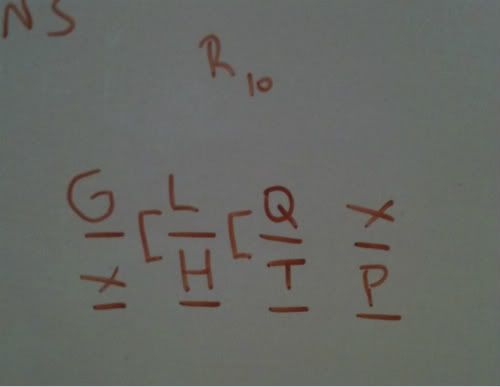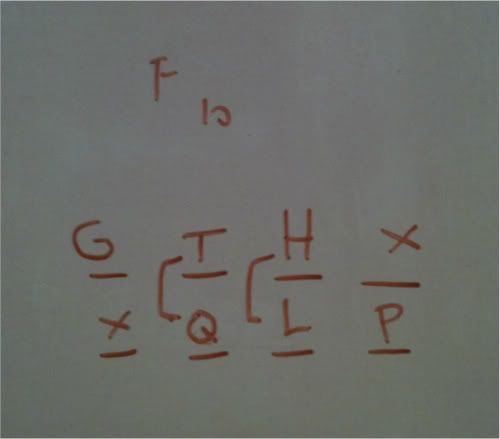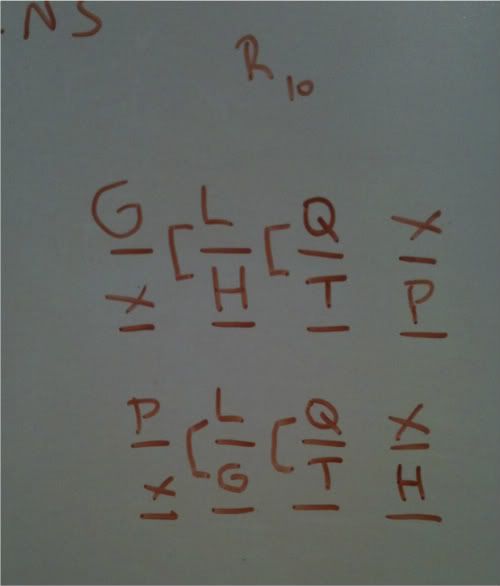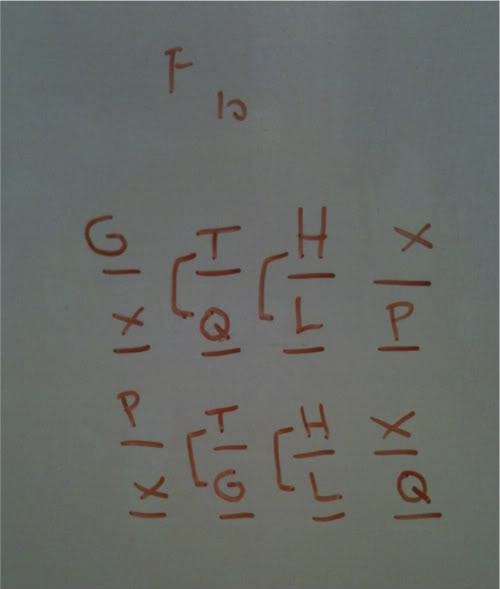My basic diagram had 2 rows, N and S with 6, 8, 10 for N and 8, 10, 12 for S. After diagramming out the rules and making the no Q or H in 6 and no G in 12, every question seemed to take forever to solve as I had to go through multiple hypotheticals. Anyone have any clues on where I went wrong and what I should have been looking at? It seems like I'm overlooking a key inference. Perhaps setting up frames with the P rule?????
Help.........
LSAT Forum
12 postsPage 1 of 1
-

- unclefester2013
-
Thanks Received: 1
-
Vinny Gambini

- Posts: 16
- Joined: July 01st, 2009

- First Responder
-

- dan
-
Thanks Received: 155
-
Atticus Finch

- Posts: 202
- Joined: March 10th, 2009
- This post thanked 3 times.
Re: Game 4, Rockers and Folk
Here's a solution for this game. I might recommend taking a look at the setup and then trying to solve the questions on your own before you check the solution for each question.
Good luck!
dan
Good luck!
dan
- Attachments
-
- PT48, S2, G4- Concert Stages- ManhattanLSAT.pdf
- (119.42 KiB) Downloaded 1216 times
-

- unclefester2013
-
Thanks Received: 1
-
Vinny Gambini

- Posts: 16
- Joined: July 01st, 2009

- First Responder
Re: Game 4, Rockers and Folk
Many thanks Dan!!
-

- timmydoeslsat
-
Thanks Received: 887
-
Atticus Finch

- Posts: 1136
- Joined: June 20th, 2011
- This post thanked 2 times.

- Most Thanked

- First Responder
Re: Diagram
It is amazing how repeating games is actually beneficial...
I have done this game probably 5 times before, but when I did it today, I had a spark that led me to frame this in terms of p going at 6 and then p going at 12.
This is context of realizing that the [R10->~F10] rule, which really means that 10 is either all folk or all rock, can be used to create two options for p at 6, and then 2 options for p at 12.

I decide to have 2 columns, one representing what happens when we have an all folk at 10, and one with an all rock at 10.
I know that I need to show P at 6 and then at 12.
My first set up was with P at 12.
I decide to set up the rock at 10 because I felt that this would be the simplest since only Q and T are left.

I place Q and T at 10, with Q being N stage and T being S stage. I no longer have to worry about the Q immediately following a folk, as no matter how I complete this diagram...that rule will take care of itself because I only have folk left to distribute. I know that G has to come before H, thus the G will go at 6. I now have H and L left, and their order can flip like Q and T, as long as we flip them at the same time.
Now for the folk at 10 with P at 12...

Well I know that I need a vertical block consisting of 2 of 3 folk: GHL.
I know that G cannot be in this block with P at 12. This is because we will have nowhere to place H.
I now know that this block will be of H and L.
I arbitrarily place H in the north with L in the south, knowing that I will probably be able to run the same concept of flipping them. Although I am ready to run another hypothetical if things are too complicated.
I now turn my attention to where Q must go. I know that it must go at the 8 slot, although I do not know which one, n or s.
This is because Q must come immediately after a folk, so its only option is the 8.
I now know that G must be in the 6, as it is the only folk left for Q to follow. This leaves me with T, and I know it must be opposite of L, so T will be n and Q will be s. I now show the flipping aspect, but they must both be flipped when flipping.
Now we need to do the f10 and r10 idea with P going at 6.

I decide to once again do the r10 first because I only have 2 r's left, Q and T.

I arbitrarily put Q in the n and T in the s.
The Q immediately following a folk group rule will be taken care of necessarily with my placement, so we do not have to worry about this one.
I do know that G has to come before H, this means that H must go 12.
We know that G will be in the 8 slot since P is 6. Now we need to accommodate the T-L different stage rule, so I place L in the n and G in the s. I add the flipping aspect to it.
Now we do the last one, P at 6 with the f10 grouping.

I realize that G cannot go with H in this vertical block of folk at 10, so what about L with G? This would force H into the 12 spot. But then we will not be able to have Q immediately follow a folk! So G cannot be in this f10 block once again. So it will be L and H. I arbitrarily place H in the n and L in the s.
I can arrive at my next deduction in either thought process:
1) The Q has to immediately follow a folk. This is only possible with Q going at 12. This forces T and G into the 8 slot, which would make us adhere to the T-L rule and use our flipping aspect.
2) We realize that T must be opposite stage of L, which requires T being in north at 8. We also know that G must come before H, which means that G will be south at 8. Only one variable left to place, the Q, and it can validly go at 12 as it follows folk.
So we have four frames that have reversible pieces and encompass every scenario. In hindsight, I would have placed the 8 and 10 slots in a block and had one reversible handle on it to denote its reversibility as one way with both slots going at the same time.
I have done this game probably 5 times before, but when I did it today, I had a spark that led me to frame this in terms of p going at 6 and then p going at 12.
This is context of realizing that the [R10->~F10] rule, which really means that 10 is either all folk or all rock, can be used to create two options for p at 6, and then 2 options for p at 12.

I decide to have 2 columns, one representing what happens when we have an all folk at 10, and one with an all rock at 10.
I know that I need to show P at 6 and then at 12.
My first set up was with P at 12.
I decide to set up the rock at 10 because I felt that this would be the simplest since only Q and T are left.

I place Q and T at 10, with Q being N stage and T being S stage. I no longer have to worry about the Q immediately following a folk, as no matter how I complete this diagram...that rule will take care of itself because I only have folk left to distribute. I know that G has to come before H, thus the G will go at 6. I now have H and L left, and their order can flip like Q and T, as long as we flip them at the same time.
Now for the folk at 10 with P at 12...

Well I know that I need a vertical block consisting of 2 of 3 folk: GHL.
I know that G cannot be in this block with P at 12. This is because we will have nowhere to place H.
I now know that this block will be of H and L.
I arbitrarily place H in the north with L in the south, knowing that I will probably be able to run the same concept of flipping them. Although I am ready to run another hypothetical if things are too complicated.
I now turn my attention to where Q must go. I know that it must go at the 8 slot, although I do not know which one, n or s.
This is because Q must come immediately after a folk, so its only option is the 8.
I now know that G must be in the 6, as it is the only folk left for Q to follow. This leaves me with T, and I know it must be opposite of L, so T will be n and Q will be s. I now show the flipping aspect, but they must both be flipped when flipping.
Now we need to do the f10 and r10 idea with P going at 6.

I decide to once again do the r10 first because I only have 2 r's left, Q and T.

I arbitrarily put Q in the n and T in the s.
The Q immediately following a folk group rule will be taken care of necessarily with my placement, so we do not have to worry about this one.
I do know that G has to come before H, this means that H must go 12.
We know that G will be in the 8 slot since P is 6. Now we need to accommodate the T-L different stage rule, so I place L in the n and G in the s. I add the flipping aspect to it.
Now we do the last one, P at 6 with the f10 grouping.

I realize that G cannot go with H in this vertical block of folk at 10, so what about L with G? This would force H into the 12 spot. But then we will not be able to have Q immediately follow a folk! So G cannot be in this f10 block once again. So it will be L and H. I arbitrarily place H in the n and L in the s.
I can arrive at my next deduction in either thought process:
1) The Q has to immediately follow a folk. This is only possible with Q going at 12. This forces T and G into the 8 slot, which would make us adhere to the T-L rule and use our flipping aspect.
2) We realize that T must be opposite stage of L, which requires T being in north at 8. We also know that G must come before H, which means that G will be south at 8. Only one variable left to place, the Q, and it can validly go at 12 as it follows folk.
So we have four frames that have reversible pieces and encompass every scenario. In hindsight, I would have placed the 8 and 10 slots in a block and had one reversible handle on it to denote its reversibility as one way with both slots going at the same time.
-

- ManhattanPrepLSAT1
-
Thanks Received: 1909
-
Atticus Finch

- Posts: 2851
- Joined: October 07th, 2009
Re: Diagram
That's absolutely fantastic work Timmy! Honestly, that's a game that always felt like it could be framed, but never worked out for me. I'll be showing people your approach for years! Thank you.
-

- rakshani15
-
Thanks Received: 0
-
Vinny Gambini

- Posts: 1
- Joined: June 12th, 2012
Re: Diagram
Timmy's brilliant diagram and work has made this solving this game a piece of cake!!! Thanks Timmy!
-

- stacksdoe
-
Thanks Received: 0
- Forum Guests
- Posts: 54
- Joined: August 19th, 2012
Re: Diagram
I'm going to return to this when I get home. But my initial insight tells me that you wouldn't have enough time to make all the frames so I created three frames.
! frame that shows what happens when Q or T go in slot 10 ( which is, that they both go in 10). I had when Q goes in 10north and when T goes into 10north.
I then created a third frame without Tor Q in 10. This would leave only G,H,L, however, after some analysis, it becomes evident that G can not go in slot 10, leaving only H and L to fill in both 10north and south.
I will post my diagrams on here in the very near future.
My next goal is to evaluate whether this game is more efficiently done without frames or with frames.
! frame that shows what happens when Q or T go in slot 10 ( which is, that they both go in 10). I had when Q goes in 10north and when T goes into 10north.
I then created a third frame without Tor Q in 10. This would leave only G,H,L, however, after some analysis, it becomes evident that G can not go in slot 10, leaving only H and L to fill in both 10north and south.
I will post my diagrams on here in the very near future.
My next goal is to evaluate whether this game is more efficiently done without frames or with frames.
-

- stacksdoe
-
Thanks Received: 0
- Forum Guests
- Posts: 54
- Joined: August 19th, 2012
Re: Diagram
Here it is:
FYI: I know another test taker used the conditional that places P into 12 or 6, and that is also fine too. There is always more then way to get the correct solution!
I used the conditional QT into slot 10 or lack of to produce three frames! Please let me know if I erred!
I had to remove my images and attach the document because the format went wacko! So much for that, I don't know how to attach and I'm too tired now:
GHL folk
PQT rock
1. G/P G/L Q X
X G/H T P/H
2. G/P H/G T X
X L/H Q P/H
3. G/P G/L/Q H/L X
X G/H/Q L/H Q/P
1. L --/--T
2. G > H
3. G
H Q
L
There are only five questions to solve for this game, and there is no telling what aspect of all three cases they'll attack, thats why its best to just keep this game simple and use the rules to attack the game. Some of the inferences are so hidden it's nearly inefficient to try and produce them.
In fact, so far I have been told to solve this game without any frames. For me, I like to produce a few key inferences, and even hypotheticals, especially when it effects the entire set up, as QT into 10 or lack of does.
If at first it's not possible to see that L or T can not go into slot 6 at any point, well then questions 20 will give you that inference; and with two questions to go, I would insert that into your master diagram. All in all, this is one of those seemly difficult games because of the complexities and conditionals involved, but detail analysis will prove its much easier then it seems.
PS: the only question I had to produce a mini sketch for was # 21, just to be safe; but as you can see, it's not necessary if you have a keen eye!
Good luck folks: PS is anyone taking the october 2015 lsat?
FYI: I know another test taker used the conditional that places P into 12 or 6, and that is also fine too. There is always more then way to get the correct solution!
I used the conditional QT into slot 10 or lack of to produce three frames! Please let me know if I erred!
I had to remove my images and attach the document because the format went wacko! So much for that, I don't know how to attach and I'm too tired now:
GHL folk
PQT rock
1. G/P G/L Q X
X G/H T P/H
2. G/P H/G T X
X L/H Q P/H
3. G/P G/L/Q H/L X
X G/H/Q L/H Q/P
1. L --/--T
2. G > H
3. G
H Q
L
There are only five questions to solve for this game, and there is no telling what aspect of all three cases they'll attack, thats why its best to just keep this game simple and use the rules to attack the game. Some of the inferences are so hidden it's nearly inefficient to try and produce them.
In fact, so far I have been told to solve this game without any frames. For me, I like to produce a few key inferences, and even hypotheticals, especially when it effects the entire set up, as QT into 10 or lack of does.
If at first it's not possible to see that L or T can not go into slot 6 at any point, well then questions 20 will give you that inference; and with two questions to go, I would insert that into your master diagram. All in all, this is one of those seemly difficult games because of the complexities and conditionals involved, but detail analysis will prove its much easier then it seems.
PS: the only question I had to produce a mini sketch for was # 21, just to be safe; but as you can see, it's not necessary if you have a keen eye!
Good luck folks: PS is anyone taking the october 2015 lsat?
-

- stacksdoe
-
Thanks Received: 0
- Forum Guests
- Posts: 54
- Joined: August 19th, 2012
Re: Diagram
After playing this game a few more times and breaking it apart, my belief is that it is not worth to frame any possibility/frame. Instead just notate the conditional if Q/T10 then Q/T is the other 10 slot. The new information provided by questions 19 and 20 are pretty helpful and allow a better grasp of the game. Without the frames you must focus on the rules and the master sketch. All in all, I only had to construct three mini sketches next to the questions. However, if you do make frames you will clearly gain a stronger grasp on the game from the onset and the questions may seem easier to solve; but the efficiency will thus take a back set.
-

- tommywallach
-
Thanks Received: 468
-
Atticus Finch

- Posts: 1041
- Joined: August 11th, 2009
Re: Diagram
I'm never a fan of more than 2 frames myself.
-

- obobob
-
Thanks Received: 1
-
Elle Woods

- Posts: 78
- Joined: January 21st, 2018
Re: Diagram
Hi, would it be better to split the gameboard (4 scenarios/boards)
or just go to the questions after writing down all the rules and inferences & restrictions on the sequencing board?
or just go to the questions after writing down all the rules and inferences & restrictions on the sequencing board?
-

- ohthatpatrick
-
Thanks Received: 3808
-
Atticus Finch

- Posts: 4661
- Joined: April 01st, 2011
Re: Diagram
That would depend heavily on the test-taker.
Someone that routinely "frames" setups and feels swift and comfortable doing so could probably talk themselves into the logic of committing to that upfront investment of time.
Anyone who is hesitant in doing so / sometimes over-infers when trying to do so / doesn't have a clear plan in terms of the 4 worlds they're building / tends to stare at worlds that DON'T have any chain reactions rather than just accepting that they're loose and should be left as is .... would be better off just going to questions.
Someone that routinely "frames" setups and feels swift and comfortable doing so could probably talk themselves into the logic of committing to that upfront investment of time.
Anyone who is hesitant in doing so / sometimes over-infers when trying to do so / doesn't have a clear plan in terms of the 4 worlds they're building / tends to stare at worlds that DON'T have any chain reactions rather than just accepting that they're loose and should be left as is .... would be better off just going to questions.
12 posts Page 1 of 1
